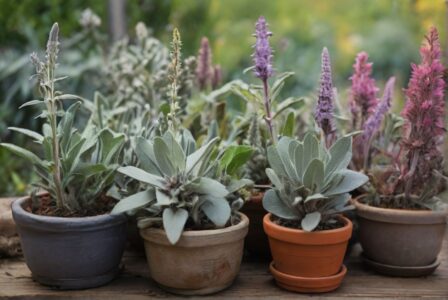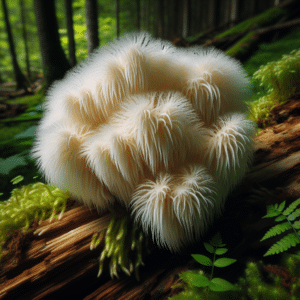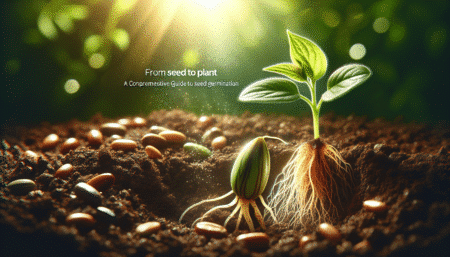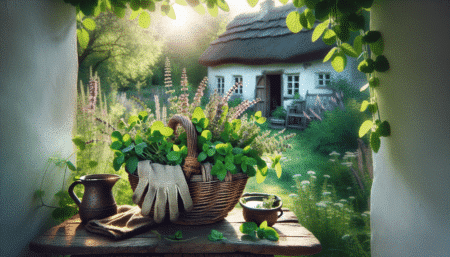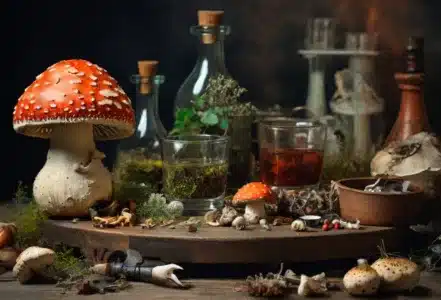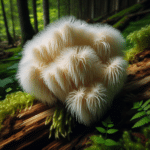- Back to the roots: European shamanism
- The oak tree: a symbol of strength and protection
- The fly agaric: gateway to other worlds
- Mistletoe: a plant of healing and ceremony
- Mugwort: The dream bringer
- Sage: cleansing and protection
- Conclusion
1. back to the roots: European shamanism
In the world of European shamanism, plants play a central role as mediators between the material and spiritual worlds. One of the best-known examples is the Toadstoolwhich is widely used in shamanic practice and serves as a gateway to other worlds. But mistletoe is also valued in seminars and workshops by practitioners such as Regina Hruska for its unique properties [2]. These plants, together with other shamanic plants (shamanic plants), are deeply rooted in tradition and custom and provide a connection to nature and the spiritual world, offer spiritual healing and promote spiritual development [3][4][7].
This article takes a comprehensive look at shamanic plants in Europe, from their historical significance in magic and customs to their role in modern herbalism and natural medicine. It explores how these plants contribute to spiritual experience through forest knowledge, self-care and the use of psychoactive substances. Readers are also given an insight into ethnobotany and the use of these plants in shamanic rituals and ayahuasca rituals[2][3][4][6][7].
2. the oak: symbol of strength and protection
The oak, known as a Martian tree, symbolizes dynamism and vitality. Its impressive presence, with specimens such as the oldest stile oak in southern Sweden, whose trunk circumference reaches 15 meters, underlines its importance as a symbol of strength and protection [10].
- Cultural and mythological significance:
- In Greek mythology, the oak was dedicated to Zeus, the god of thunder and the sky [11].
- Among the Celts, it was associated with Taranis, the god of thunder [11].
- In Norse mythology, the oak was considered sacred to Thor, the god of thunder and war [11].
- After the Christianization of the Germanic tribes, the oak became an allegory for Jesus Christ and the Virgin Mary [11].
- Ecological significance and use:
- Oaks serve as a gathering place for numerous animals and insects, including bees, and show an affinity for underground water flows [10].
- They react to mistletoe and ulcers on their branches and can polish negative water veins to positively charge the water [10].
- In the past, its bark and leaves were used to treat inflammation, women's ailments and as a coffee substitute [10].
- Shamanic and medical applications:
- Oaks play a central role in shamanic ancestral medicine. They were used for sacrificial rituals in Norse and Celtic mythology and their healing properties include antiseptic, anti-inflammatory and hemostatic effects [10][11].
- Oak bark tea was historically used to treat diarrhea, gonorrhea, syphilis and other diseases [10].
This diversity in cultural significance, ecological function and medicinal use makes the oak a central element in European shamanism and gives it the status of a symbol of strength and protection.
3. the fly agaric: gateway to other worlds
The fly agaric, known for its psychoactive propertiesplays a central role in shamanic practices. The main components, muscimol and ibotenic acid, are responsible for the hallucinogenic effects and mystical experiences that this plant can induce[13].
- Psychoactive substances:
- Muscimol: Causes altered consciousness and hallucinations.
- Ibotenic acidLeads to mystical and spiritual experiences. Both substances together enable visionary experiences and spiritual journeys, which are of great importance for shamanic ceremonies[13].
The fly agaric symbolizes not only luck and prosperity, but also the connection between heaven and earth. Its role in transformation and in the cycle of life, due to its growth and poisonous nature, emphasizes the deep symbolic meaningwhich is attributed to this plant in various cultures.
- Symbolic meaning:
- Happiness and prosperity: A sign of positive change and success.
- Connection between heaven and earthRepresents a bridge between the material and the spiritual world.
- Transformation and life cycleRepresents growth, change and the inevitable nature of life.
The Mysterious connection of the fly agaric to the Raunächte in Celtic culture and its use in shamanic rituals and ceremonies dating back thousands of years show the profound importance and influence this plant has in shamanic practice. The traditions surrounding the fly agaric are a testament to its role in spiritual development and healing through the centuries[13].
You can find our dried fly agarics here!
4 Mistletoe: a plant of healing and ceremony
Mistletoe, a parasitic tree that grows on trees, has been considered a sacred plant in many cultures [2]. Its role in Germanic mythology, particularly in the story of Baldr, the god of light, who was killed by an arrow of mistletoe from his blind brother Hödr, underlines its profound symbolic significance [2].
- Healing properties and modern applications:
- Mistletoe therapyKnown for its healing properties, mistletoe is used in various forms of therapy, including mistletoe therapy for cancer treatment [2].
- Modern medicineMistletoe extracts are used in modern medicine to lower blood pressure, treat age-related disorders and cancer therapy [14].
- Mistletoe teaCan be safely prepared with mistletoe treasure extract from a pharmacy [14].
- Cultural and protective use:
- Protection spellMistletoe is often hung over doorways during the winter to ward off evil spirits [2].
- Christmas decorationsTraditionally used as a Christmas decoration, mistletoe was believed to have magical powers to protect against witches, evil spirits, lightning and fire [14].
- Central role in Celtic mythologyIn Celtic mythology, mistletoe was a central part of their worship and was considered a sacred plant that could heal all ailments [2].
These diverse applications and symbolic meanings make mistletoe an important element in the European shamanic tradition and emphasize its role as a plant of healing and ceremony.
5. mugwort: the dream bringer
Mugwort, also known as Artemisia vulgaris, plays an important role in shamanic practices and dream work. This plant, which contains substances such as cineole and thujone, is valued for its clearing, purifying and mind-expanding effects when burned [15][16]. Mugwort is not only used in seminars and shamanic sessions, but also serves as a protective plant against various forms of misfortune [16]. Its historical use ranges from the Stone Age people to the Celts and Indo-Europeans, and it was dedicated to the goddesses Freya and Artemis [16].
- Protection and cleaning:
- Protection against fire, lightning, curses, nightmares, the evil eye and other forms of damageMugwort is used to combat negative energies such as hatred, envy, intrigue, malice and fear. It is also known as the "spirit banner" because of its ability to drive away disease-causing spirits [16].
- Use in protective and cleansing incenses and in herbal teas: In Germanic mythology, mugwort is associated with the god Thor and used against dark forces [16].
- Medical and therapeutic use:
- Traditional medicineMugwort is used for various purposes, such as improving fat digestion, supporting pancreatic function and treating bile and liver diseases [16].
- Mugwort teaRecommended to stimulate menstruation, during the menopause and can help with irregular or absent periods (pregnancy excluded). It can also be helpful for tension headaches, nervousness, restlessness and other conditions [16].
- Homeopathy and nutritionMugwort root is used in homeopathy for cramps, gastrointestinal problems and general weakness. Fresh mugwort leaves can be added to salads and vegetables for a healing effect. "Lady's mugwort" (wormwood), a milder variety of mugwort, is particularly favored by women [16].
Mugwort is a key element in the practice of "dream work" due to its ability to enhance dream recall and induce lucid dreaming. It is recommended to drink mugwort tea for 3 weeks, 1 cup per day. A mugwort foot bath can help with tired or cold feet [16][17]. These diverse applications and the deep cultural and spiritual significance make mugwort a valuable part of European shamanic traditions and practices.
Here you can find our mugwort or Artemisia seeds!
6. sage: cleansing and protection
Sage is used in shamanic rituals for cleansing and protection. Its strong cleansing power makes it a preferred choice for more intense cleansing rituals 20. Here are some specific uses of sage in practice:
- Air purification and creation of a sacred space:
- Sage is often burned to purify the air and create a sacred space.
- Sage smoke has antimicrobial properties that can eliminate bacteria in the air 21.
- Cleaning objects, people or rooms:
- Sage can also be used to clean objects, people or rooms.
- Sage is recommended for cleaning and charging objects such as talismans, amulets and crystals 21.
- Incense rituals should be performed with a clear intention by thoroughly smoking the corners of each room. After the ritual, it is important to expel the bundle of herbs or let the incense burn out and open all windows and doors for at least 5 minutes to allow the negative energy to escape 20.
- Sage & Juniper Smudge Stick:
- The Sage & Juniper Smudge Stick, made from white sage and juniper, is a popular product for spiritual cleansing and protection 19.
- It is used by lighting the end, blowing out the flame and letting the smoke hover around the person or area to be cleaned 19.
- This product measures 25 cm in length and weighs 80 g 19.
Sage not only has an important role in shamanic rituals and incense, but also has numerous medicinal applications. Its antibacterial, anti-inflammatory, astringent and diuretic properties make it a versatile remedy for a variety of ailments, including loss of appetite, flatulence, bronchitis, colds, sore throats, coughs, whooping coughs, mouth and throat infections, skin conditions, insect bites, nervousness and rheumatism 21.
Here you can find our different sage seeds!
7. conclusion
Through extensive research into shamanic plants in Europe and their deep-rooted significance in both traditional and modern practices, we have gained a multi-layered understanding of these natural allies. The findings on oak, fly agaric, mistletoe, mugwort and sage not only reveal their cultural, mythological and medicinal importance, but also emphasize their central role in the development of spiritual and healing practices. This connection between man and nature, embedded in centuries-old traditions, provides insights into the extensive possibilities that these plants hold for spiritual and physical health.
In view of the diversity and depth of European plant shamanism described above, it becomes clear that these plants are more than just part of the flora; they are teachers, healers and companions. Their potential and significance reach far beyond the purely physical level, touching both individual and collective spiritual aspects. For future research and practice, numerous avenues are opening up to deepen the understanding of these plants and expand their use to promote well-being and understanding of the natural world. The journey with these plants is a lifelong process of learning, healing and insight.
Further links and book recommendations
- Shamanism: The roots of our spirituality (Wolf-Dieter Storl)
- The ancient shamanic knowledge of our European ancestors: Druids, healers and fence riders
- European shamanism (A search for clues)
- Shamanism in Europe
Youtube
Note: The information in this article is for informational purposes only and is not intended to replace the advice of a physician or other healthcare professional. Always consult a doctor before using any new herbs or supplements. Furthermore, you should always check whether the cultivation/possession/use/processing of certain plants is permitted in your country. As we only offer ornamental plants in our store, we are only allowed to offer Provide information and advice on the correct care of plants!
Read more: Schamanenpflanzen in Europa: Eine tiefgehende UntersuchungReferences
[1] – https://www.gardenshaman.eu/en/2024/01/20/die-10-bekanntesten-schamanenpflanzen-europoas/ [2] – https://www.heilschamanismus.com/jurte-heilgarten/mistel/
[3] – https://de.wikipedia.org/wiki/Schamanismus
[4] – https://de.wikipedia.org/wiki/Schamane
[5] – https://wiki.yoga-vidya.de/Schamanismus
[6] – https://www.shamanism.eu/de/ressourcen/mediathek/beitrag/pflanzengeister-in-den-europaeischen-traditionen
[7] – https://www.hanf-magazin.com/drogenkunde/schamanenpflanzen/
[8] – https://www.heilschamanismus.com/jurte-heilgarten/jasmin/
[9] – https://www.storl.de/themen/schamanismus/
[10] – https://www.heilschamanismus.com/jurte-heilgarten/eiche/
[11] – https://www.uni-goettingen.de/de/mythologie+und+brauchtum/16703.html
[12] – https://www.gardenshaman.eu/2023/12/21/das-mysterium-der-12-raunaechte/
[13] – https://www.zobodat.at/pdf/CAR_187_107_0253-0265.pdf
[14] – https://www.liebstoeckl.eu/unser-konzept/michaels-kuechengeheimnisse/detail/mystic-mistel-kraut-mit-heilwirkung/
[15] – https://seelengaertner.at/der-gemeine-beifuss-das-heilige-raeucherkraut-der-schamanen/
[16] – https://www.heilschamanismus.com/jurte-heilgarten/beifuss/
[17] – https://heilpflanzen.thieme.de/2022/09/23/schamanenpflanze-beifuss-deine-traumwelt-bereichern-kann/
[18] – https://www.gardenshaman.eu/en/2023/11/07/smoking-in-shamanism/
[19] – https://www.calerris.com/products/smudgestick-salbei-und-wacholder
[20] – https://lenisharma.com/raeucherritual/
[21] – https://wiki.yoga-vidya.de/Salbei
[22] – https://www.harmonieoase.at/shop/Salbei-Smudge-40.html
[23] – https://www.thieme-connect.de/products/ebooks/pdf/10.1055/b-0039-172688.pdf


